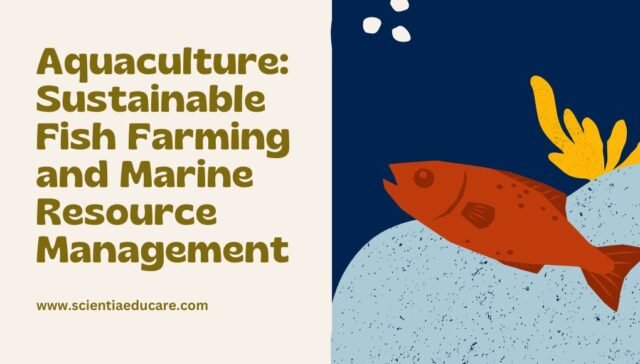Aquaculture: Sustainable Fish Farming and Marine Resource Management
Introduction
Aquaculture, also known as fish farming, is the practice of breeding, raising, and harvesting fish, shellfish, and other aquatic organisms in controlled environments. It plays a crucial role in ensuring global food security, reducing pressure on wild fish populations, and promoting economic growth.
This study module explores the various aspects of aquaculture, including its techniques, importance, benefits, challenges, and future prospects.
Best fish species for farming,
Low-cost aquaculture techniques,
Profitable aquaponics fish farming,
Eco-friendly fish farming methods,
How to start mariculture
1. Understanding Aquaculture
Aquaculture can be broadly categorized into two types:
- Freshwater Aquaculture: Involves rearing fish in freshwater bodies such as ponds, lakes, and rivers. Common species include tilapia, catfish, and carp.
- Marine Aquaculture (Mariculture): Takes place in saltwater environments like oceans, bays, and coastal regions. Common species include shrimp, salmon, and oysters.
2. Techniques of Aquaculture
a) Open Systems (Natural Water Bodies)
- Pond Culture: Fish are raised in artificial or natural ponds with controlled feeding and breeding conditions.
- Cage Culture: Fish are kept in large netted enclosures placed in lakes, rivers, or coastal waters.
- Pen Culture: Similar to cage culture but with fixed structures in shallow waters.
b) Closed Systems (Controlled Environments)
- Recirculating Aquaculture Systems (RAS): Water is filtered and reused, providing a controlled environment for fish.
- Integrated Multi-Trophic Aquaculture (IMTA): Combines different species in a single system to utilize waste as nutrients.
- Aquaponics: A combination of aquaculture and hydroponics (growing plants without soil) where fish waste fertilizes plants.
3. Importance of Aquaculture
a) Food Security and Nutrition
- Provides high-protein food to meet global nutritional demands.
- Reduces dependency on wild fish populations, ensuring sustainability.
b) Economic Benefits
- Generates employment opportunities in coastal and rural areas.
- Contributes to national economies through exports and trade.
c) Environmental Benefits
- Reduces overfishing and preserves marine biodiversity.
- Supports ecosystem-based approaches through integrated farming methods.
4. Challenges in Aquaculture
a) Environmental Concerns
- Water pollution due to excess feed and waste accumulation.
- Disease outbreaks affecting farmed species and wild populations.
b) Resource Management
- Overuse of antibiotics leading to antibiotic resistance.
- Dependency on wild fish for feed, impacting marine food chains.
c) Socioeconomic Issues
- Conflicts over water use between farmers and local communities.
- High initial investment and maintenance costs.
5. Sustainable Practices in Aquaculture
- Eco-friendly Feed Alternatives: Using plant-based and insect-based feeds instead of wild fish-based feeds.
- Efficient Water Management: Recycling and purifying water to minimize waste discharge.
- Selective Breeding: Developing disease-resistant and fast-growing fish strains.
- Organic Aquaculture: Avoiding synthetic chemicals and promoting natural growth processes.
6. Future of Aquaculture
With advancements in biotechnology, artificial intelligence, and automation, aquaculture is evolving rapidly. Some future trends include:
- Genetic Engineering: Improving fish traits for higher resistance to diseases.
- Smart Farming Technologies: Using AI and IoT (Internet of Things) for real-time monitoring of water quality and fish health.
- Marine Spatial Planning: Identifying suitable areas for aquaculture to balance environmental and economic interests.
7. Conclusion
Aquaculture is a promising solution to meet the growing demand for seafood while ensuring sustainability. By adopting eco-friendly techniques and innovative practices, the industry can continue to thrive while protecting marine ecosystems.
Website URL Links for Reference
- Food and Agriculture Organization (FAO) – Aquaculture: https://www.fao.org/aquaculture/en/
- World Aquaculture Society: https://www.was.org/
- National Oceanic and Atmospheric Administration (NOAA) – Aquaculture: https://www.noaa.gov/topic-tags/aquaculture
Further Reading
- Global Aquaculture Alliance: https://www.aquaculturealliance.org/
- Aquaculture Stewardship Council: https://www.asc-aqua.org/
- Marine Stewardship Council: https://www.msc.org/
This study module provides a comprehensive overview of aquaculture, its techniques, importance, and sustainability measures. It is beneficial for students, researchers, and professionals involved in fisheries and marine resource management.
Multiple-choice questions (MCQs) on “Aquaculture: Fish Farming and Marine Resources”
1. What is aquaculture?
A) The cultivation of land crops
B) The breeding, rearing, and harvesting of fish and other aquatic organisms
C) The study of marine biodiversity
D) The study of ocean currents
✅ Correct Answer: B
Explanation: Aquaculture is the controlled farming of aquatic organisms, including fish, shellfish, and algae, in freshwater and marine environments.
2. Which of the following is an example of freshwater aquaculture?
A) Shrimp farming
B) Salmon farming
C) Carp farming
D) Oyster farming
✅ Correct Answer: C
Explanation: Carp farming is commonly practiced in freshwater environments, whereas shrimp and oysters are typically farmed in marine or brackish waters.
3. What is the main purpose of fish farming?
A) To conserve marine biodiversity
B) To reduce global warming
C) To increase fish production for human consumption
D) To control marine pollution
✅ Correct Answer: C
Explanation: Fish farming is primarily done to meet the growing demand for seafood and reduce pressure on wild fish populations.
4. Which type of aquaculture is practiced in coastal regions using cages or enclosures in the sea?
A) Mariculture
B) Inland aquaculture
C) Integrated aquaculture
D) Hydroponics
✅ Correct Answer: A
Explanation: Mariculture is a branch of aquaculture that involves farming marine species in oceanic waters, bays, or enclosed coastal areas.
5. What is the term for the artificial breeding and raising of fish in a controlled environment?
A) Pisciculture
B) Apiculture
C) Sericulture
D) Horticulture
✅ Correct Answer: A
Explanation: Pisciculture is the cultivation of fish for commercial and conservation purposes.
6. Which of the following is NOT a common fish species used in aquaculture?
A) Tilapia
B) Catfish
C) Goldfish
D) Salmon
✅ Correct Answer: C
Explanation: Goldfish are primarily ornamental fish and are not widely cultivated for food production.
7. What is the main benefit of polyculture in fish farming?
A) It helps in reducing water pollution
B) It allows different species to grow together efficiently
C) It prevents fish diseases
D) It requires no artificial feeding
✅ Correct Answer: B
Explanation: Polyculture involves raising multiple compatible species in the same environment, maximizing resource use and improving productivity.
8. What is the role of biofilters in aquaponics?
A) To supply oxygen to fish
B) To convert fish waste into nutrients for plants
C) To prevent fish diseases
D) To kill harmful bacteria
✅ Correct Answer: B
Explanation: Biofilters facilitate the nitrogen cycle by converting fish waste into nutrients that plants can absorb, making aquaponics a sustainable system.
9. Which is a major environmental concern of aquaculture?
A) Increased water purity
B) Spread of diseases to wild fish populations
C) Decreased demand for seafood
D) Reduced oxygen in the air
✅ Correct Answer: B
Explanation: Intensive fish farming can lead to disease outbreaks, which may spread to wild fish populations and disrupt ecosystems.
10. What is the process of adding oxygen to fish tanks called?
A) Sedimentation
B) Aeration
C) Filtration
D) Bioaugmentation
✅ Correct Answer: B
Explanation: Aeration ensures that fish receive adequate oxygen levels necessary for their survival and growth.
11. What is the ideal pH range for freshwater fish farming?
A) 3.5 – 4.5
B) 5.0 – 6.0
C) 6.5 – 8.5
D) 9.0 – 10.5
✅ Correct Answer: C
Explanation: Most freshwater fish species thrive in a pH range of 6.5 to 8.5, ensuring proper metabolic and respiratory functions.
12. Which country is the largest producer of aquaculture products?
A) USA
B) India
C) China
D) Brazil
✅ Correct Answer: C
Explanation: China leads the world in aquaculture production, contributing significantly to global fish supply.
13. What is the major source of protein in fish feed?
A) Wheat
B) Soybean meal
C) Corn starch
D) Salt
✅ Correct Answer: B
Explanation: Soybean meal is commonly used as a protein source in fish feed due to its high nutritional value.
14. What is recirculating aquaculture system (RAS)?
A) A system that uses natural ponds for fish farming
B) A closed-loop system that filters and reuses water
C) A method of deep-sea fishing
D) A system that uses ocean currents for fish growth
✅ Correct Answer: B
Explanation: RAS is an advanced aquaculture system that minimizes water use by continuously filtering and recirculating it.
15. Which of the following is a disadvantage of aquaculture?
A) Overfishing of wild stocks
B) Increased dependency on seafood imports
C) Pollution due to uneaten feed and waste
D) Lack of availability of fish
✅ Correct Answer: C
Explanation: Intensive aquaculture can lead to water pollution from excess feed, fish waste, and chemicals used in fish farming.
16. What is the most commonly farmed fish in the world?
A) Salmon
B) Tilapia
C) Tuna
D) Mackerel
✅ Correct Answer: B
Explanation: Tilapia is widely farmed due to its fast growth, adaptability, and high nutritional value.
17. Which of the following is a marine aquaculture species?
A) Catfish
B) Trout
C) Oyster
D) Koi
✅ Correct Answer: C
Explanation: Oysters are cultivated in marine or brackish waters and are an important part of mariculture.














